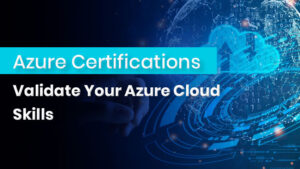
How to Harden Your Infrastructure Using CIS Benchmarks
How to Harden Your Infrastructure Using CIS Benchmarks Introduction As more organizations go faster with their digital transformation, the security and resilience of IT infrastructure
Limited-Time Offer! Get an exclusive 40% OFF on IPSpecialist Premium Monthly & Annual Plans. Use Promo Code: UPSKILLNOW at checkout.

How to Harden Your Infrastructure Using CIS Benchmarks Introduction As more organizations go faster with their digital transformation, the security and resilience of IT infrastructure

Azure Certifications – Validate Your Azure Cloud Skills Introduction Cloud computing has transformed the business landscape, providing scalability, flexibility, and affordability in a way

Top Cyber Security Trends: What Every Organization Must Know Introduction In an era marked by digital transformation, remote workforces, and rapidly evolving threat landscapes,
Table of Contents
The demand for scalable, reliable, and secure cloud services has never been higher in today’s digital landscape. AWS Global Infrastructure is a beacon of innovation in this domain, offering a vast network of data centers strategically positioned worldwide. With components like Regions, Availability Zones, Local Zones, Edge Locations, Regional Edge Caches, and Wavelength Zones, AWS provides a robust ecosystem to meet the diverse needs of businesses and organizations. In this blog, we’ll delve into the critical components of AWS Global Infrastructure, explore its benefits, and highlight essential certifications and courses for individuals looking to enhance their understanding and proficiency in this dynamic field.
Dive deeper into the world of cloud technology and IT mastery with IPSpecialist! Get a better understanding of AWS Global Infrastructure using the AWS Certified Cloud Practitioner course by IPSpecialist. Within its pages, you’ll uncover profound insights that can serve as guiding beacons on your journey toward AWS Cloud Environment.
The AWS Global Infrastructure is a vast network of data centers and resources strategically located worldwide to provide cloud services. The infrastructure comprises multiple interconnected components, such as Regions, Availability Zones, Local Zones, and Wavelength Zones.
AWS Global Infrastructure’s main component is data centers called Availability Zones (AZ). AZs are isolated locations within AWS Regions. The AWS Global Infrastructure Map includes 102 Availability Zones spread across 32 geographic regions globally. Moreover, plans are underway to expand with an additional 12 Availability Zones and 4 more AWS Regions, covering countries like Canada, Malaysia, New Zealand, and Thailand.
The AWS Global Infrastructure represents a highly distributed and robust ecosystem of data centers, ensuring global coverage, reliability, and performance for a wide array of cloud-based services and applications. Here are the 6 components of AWS Global Infrastructure:
An AWS Region is a distinct geographical area worldwide where a collection of data centers is clustered. This model incorporates multiple Availability Zones and physically and logically separate logical data center groups. Each AWS Region comprises at least three Availability Zones, ensuring geographic redundancy and high availability.
AWS Regions and Availability Zones are not the same. AWS Regions are the larger geographical areas where data centers are located, while Availability Zones are subsets within those regions. We will discuss AZs intensely in the next part.
AWS operates in several geographic regions, including North America, South America, Europe, China, Asia Pacific, South Africa, and the Middle East.
People often refer to Availability Zones (AZs) in AWS as data center facilities. Each Availability Zone is a physically separated data center with power and infrastructure. AWS has strategically designed these Availability Zones to provide redundancy and resiliency for applications and services.
AWS Availability Zones have their own power, cooling, and networking infrastructure. Deploying resources across multiple Availability Zones ensures that if one AZ experiences issues or downtime, it enables the others to continue operating, thereby enhancing the overall resilience of applications hosted on the AWS platform.
Here is the complete list of AWS data center locations in all regions:
AWS Local Zones are a part of the AWS Global infrastructure that brings cloud services locally to specific areas with a high concentration of users and applications. These Local Zones are a subset of AWS Availability Zones near specific metropolitan areas.
Local Zones allow customers to deploy applications that require low latency to end-users or specific resources in those geographic areas. They are handy for applications that require real-time processing, such as gaming, interactive multimedia, and financial services, where reducing latency is critical for a seamless user experience.
AWS Edge Locations are endpoints for Amazon Web Services’ CloudFront service. They are strategically distributed data centers situated in various areas around the world. These Edge Locations act as caching servers that store copies of frequently accessed content, such as images, videos, web pages, and other static files, closer to the end users.
The Edge Location closest to the client receives requests for content distributed via CloudFront. This reduces latency and improves the overall performance of the application or website if the content already exists at that Edge Location. If the content still needs to be cached, the Edge Location retrieves it from the origin server (such as an Amazon S3 bucket or a custom origin) and caches it for subsequent requests.
Like edge locations, Regional Edge Caches are CloudFront service sites strategically placed worldwide near your viewers. They deliver content directly to viewers between your origin server and global edge locations.
Regional edge caches assist with many sorts of material, especially content that becomes less popular over time. Examples are user-generated material, e-commerce assets, news, and other content that may rapidly gain popularity.
AWS Wavelength is an Amazon Web Services (AWS) service that brings cloud services to the edge of 5G networks. It supports real-time gaming, augmented reality (AR), virtual reality (VR), video streaming, and other applications that require ultra-low latency and high bandwidth connectivity.
A Wavelength Zone is a specialized infrastructure deployment within a data center run by a telecommunications provider.
These zones are strategically placed near 5G base stations, directly connecting the AWS resources and the 5G network. The proximity minimizes latency for applications requiring instant responses.
The AWS Global Infrastructure offers 6 key benefits to businesses and organizations that leverage its services, as mentioned on the AWS website: security, availability, performance, scalability, flexibility, and global footprint.
Security: AWS offers robust security measures, including encryption and constant monitoring. You maintain control over your data with encryption, movement, and retention options.
Availability: AWS ensures the utmost network availability among cloud providers. Each region is isolated and divided into multiple Availability Zones (AZs). If one AZ experiences an issue, other AZs can continue to operate without interruption.
Performance: Low latency, minimal packet loss, and high network quality are all characteristics of AWS Global Infrastructure.
Scalability: AWS enables flexible scaling of resources, eliminating over-provisioning. You can instantly adjust resources based on business needs, rapidly deploying hundreds or thousands of servers.
Flexibility: You can choose how and where to run workloads, utilizing the same network, control plane, APIs, and services. Options include global AWS Regions, AWS Local Zones, AWS Wavelength for low latency, and AWS Outposts for on-premises deployment.
Global Footprint: AWS has an extensive global infrastructure presence. You can select technology infrastructure close to your intended users, ensuring ideal assistance for a wide range of applications, from high throughput to low-latency performance.
To become proficient in understanding and working with AWS Global Infrastructure, you can pursue specific AWS certifications and courses that cover relevant concepts, technologies, and best practices. Here are the top 3 essential AWS certifications and courses that can help you learn about AWS Global Infrastructure:
The AWS Certified Cloud Practitioner certification provides a solid overview of AWS services, pricing models, architecture, security, and the overall benefits of cloud computing. This certification is ideal for beginners who are new to cloud technology and want to grasp the fundamental concepts, services, and benefits of cloud computing.
The AWS Certified Cloud Practitioner certification is a great starting point for anyone looking to build a foundational understanding of Amazon Web Services and cloud computing concepts. It does not dive into the technical details of specific AWS services.
AWS Certified Solutions Architect – Associate certification covers a broad range of AWS services and architectural best practices, including designing and deploying applications on a global scale using multiple regions and Availability Zones.
AWS Certified Solutions Architect – Associate certification is ideal for individuals who want to showcase their expertise in architecting solutions using AWS services, including global infrastructure-related ones.
The AWS Certified Solutions Architect – Professional certification is an advanced-level certification offered by Amazon Web Services (AWS). AWS Cloud professionals with extensive experience and expertise in designing and deploying complex applications are ideal candidates for this program.
Building on the associate-level certification, AWS Certified Solutions Architect – Professional certification goes deeper into advanced architectural concepts, including designing highly available and fault-tolerant systems across a global infrastructure.
In conclusion, AWS Global Infrastructure is a cornerstone of modern cloud computing, offering a robust and scalable platform for businesses and organizations worldwide. With its distributed network of data centers, high availability, security, and performance, AWS enables businesses to innovate, scale, and adapt to evolving market demands effectively. Individuals can position themselves for lucrative career opportunities in this dynamic and rapidly evolving field by investing in certifications and courses tailored to AWS Global Infrastructure.
AWS Global Infrastructure distinguishes itself through its extensive network of data centers, spanning multiple regions and Availability Zones globally. This ensures high availability, scalability, and performance for cloud-based services and applications. Additionally, AWS offers a comprehensive suite of security measures, enabling businesses to control their data and mitigate potential risks effectively.
With its distributed network of Availability Zones, AWS Global Infrastructure enhances business continuity by providing redundancy and resiliency for applications and services. In an outage or failure in one Availability Zone, others can seamlessly continue operations, minimizing disruptions. This architecture also facilitates robust disaster recovery strategies, enabling businesses to recover data and services quickly in case of unforeseen events.
Proficiency in AWS Global Infrastructure opens up many career opportunities in the rapidly growing cloud computing industry. Individuals with certifications such as AWS Cloud Practitioner, AWS Certified Solutions Architect – Associate, and AWS Certified Solutions Architect – Professional are highly sought after by organizations seeking to leverage AWS services effectively. Roles may include cloud architects, solutions engineers, system administrators, and cloud security specialists.
© 2025 All rights reserved | Privacy Policy | Terms and Conditions | Sitemap | Cookie Policy

